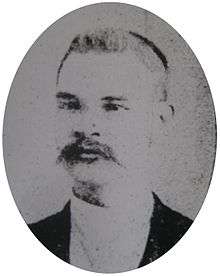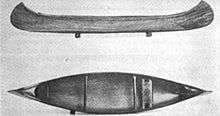Henry L. Haskell
Henry Lincoln Haskell (January 2, 1863 – April 3, 1940) was a businessman and inventor. He ran manufacturing businesses related to plywood and lived in Ludington, Michigan, US.

Early life
Haskell was born on January 2, 1863 in Aurelius of Ingham County, Michigan (then Jackson County). His father was Reuben Sprague Haskell (1813–1890), and his mother was Mary McGee Haskell (1816–1876). He moved with his family in 1865 at two years old to Olivet, Michigan. There, he attended the local public schools when growing up. After graduating from high school, he attended Olivet College.[1] In 1882, when he was 19 years old, he moved to Ludington, Michigan for work in the lumber industry.[2]
Mid-life
Haskell established a basket factory in Ludington in 1883 when he was 20 years old.[2] This became the Ludington Novelty company in 1889 that made various items, among them games.[3] The company bought out Archarena Company, a manufacturer of games, in 1902 and called itself the Carrom-Archarena Company. This name was later shortened to the Carrom Company.[4] Haskell devised a game board named Carroms in 1889 to keep young boys out of pool halls.[5] He believed young boys might pick up bad habits in such venues, and wanted them to develop family associations instead.[6][7] He patented his Carroms game board in 1892.[8] Haskell first made these by hand with the assistance of crude planing equipment[9], and he started to mass-produce the game board in 1893.[10] The cloth corner pockets of string for the four corners of the Carrom board were made by Ludington housewives and provided a source of extra income.[3] He found the people of Iowa bought his game more than anyone else.[10] The president of the Carrom Company in 1988 suggested that the concept of the game may have originated in India as Karroom prior to the American game.[4]

Haskell innovated a formula for a waterproof glue in 1913,[11] made from blood albumin.[12] From this glue, he made a material of "plies" of crossed-grain layers of wood, which is known today as plywood.[13] Haskell named this composite material after himself with the brand name Haskelite. He worked out the mechanics of being able to mold and shape this material into three dimensions.[14] From this plywood, he made a canoe that was molded from one piece of plywood.[15] The canoe plywood was shaped by hydraulic presses as an innovation devised by Haskell.[16] The unusually designed canoe of no skeleton framework or ribs was given the brand name Arex ("king of the water") and made out of the Haskell Manufacturing Company building on N. Rowe Street in Ludington[17], and later became better known just as the Haskell canoe. Haskell formed the Haskell Manufacturing Company in 1916 to make boats and canoes[18], and incorporated it with $100,000 in 1917.[18] The Haskell Boat Company made 600 Haskell canoes in the first year.[19]
The second factory, Haskelite Manufacturing Corporation of Grand Rapids, discontinued making canoes in 1918 and made plywood exclusively for the US government and its allies during World War I. Over three thousand military airplanes were made with Haskell's plywood.[20] After 1922, Haskell again made boats, canoes, oars and paddles until 1934. During this same time he also made wooden aircraft parts for commercial airplanes with the shaped molded plywood. Most of the airplane parts made for the next three decades were the fuselage and wings.[21] The airplane parts were based on his patent of "Aeroplane-body" (US 1344634 A). The first heavier-than-air machine to fly across the Atlantic Ocean, the Curtiss NC-4, was made from Haskelite.[19]
Personal life
Haskell married Miss Elizabeth Thayer, a Latin teacher at the Ludington High School, in 1892 when he was 29 years old. Thayer was from Plymouth, Michigan. Their children were Helen Thayer Haskell (born 1894), John Paul (born 1898), and Mary Elizabeth (born 1903).[2] Haskell and his wife were members of the Congregational Church in Ludington.[22] Haskell served on the Ludington School Board and on the Ludington Library Board, and also served as the county probation officer.[2] Haskell died in Detroit at the age of 78 on April 3, 1940, and he was buried in Thayer cemetery at Northville, Michigan.[23]
References
- "Mrs. Sarah Mapes of Olivet, Dies". Lansing State Journal. Lansing, Michigan. October 9, 1917 – via Newspapers.com

- "Services Friday for H.L.Haskell". Ludington Daily News. Ludington, Michigan. April 6, 1940 – via Newspapers.com

- Williams, Leonard P. (December 22, 1952). "Carrom Industries / from Lumber to Game Boards". Daily News. Ludington, Michigan – via Newspapers.com

- "Carrom – king in Ludington". Daily News (page 1). Ludington, Michigan. February 5, 1988 – via Newspapers.com

- Anne McCollam (July 11, 2003). "Vintage game's value caroms". Ukiah Daily Journal. Ukiah, California – via Newspapers.com

- "Industry on Parade". Daily News. Ludington, Michigan. December 22, 1952 – via Newspapers.com

- "Carrom Company is Diversified". Daily News. Ludington, Michigan. September 3, 1965 – via Newspapers.com

- "Local Company Contributed to war effort". Daily News. Ludington, Michigan. June 26, 1993.
- Cabot, James L. (February 27, 1990). "My Turn – Carrom source material origins". Daily News (p. 4). Ludington, Michigan.
- "veneer plant canoe". Daily News. Ludington, Michigan. March 20, 1934. p. 6 – via Newspapers.com

- John 1930, p. 18.
- "Haskell Canoe". Online Library. Mason County Historical Society. 2016. Retrieved May 5, 2016.
The plywood and glue was made from albumin blood from Chicago stock yards.
- "Henry L. Haskell". Ludington Daily News. Ludington, Michigan. April 5, 1940. p. 4.
- Saarinen 2006, p. 257.
- John 1930, p. 19.
- Hard_Record 1916, p. 37.
- "Haskell Finances Company to Manufacture Canoes and Boats in Tubbs Building / Waterproof glue adds durability to veneer coatings". Daily News. Ludington, Michigan. October 19, 1916. p. 3.
- Oil_Field 1916, p. 615.
- "Ludington Man Starts Factories that pay more than $5,000,000 in Wages". Mason County Enterprise. Ludington, Michigan. May 9, 1922. p. 1.
- Dunbar 1955, p. 439.
- "Ludington is birthplace of plywood airplanes". Daily News. Ludington, Michigan. July 15, 1943.
- "Obitiary – Mrs. Helen Haskell Slater". Daily News. Ludington, Michigan. September 21, 1976.
- "Henry L. Haskell dies in Detroit". Daily News. Ludington, Michigan. April 4, 1940 – via Newspapers.com

Sources
- Dunbar, Willis Frederick (1955). Michigan Through the Centuries. Lewis Historical Publishing Company. OCLC 2025751.CS1 maint: ref=harv (link)
- Hard_Record (1916). Hardwood Record. Hardwood Company. OCLC 730996970.CS1 maint: ref=harv (link)
- John, H. F. (1930). Veneers and Plywood. S.H. Smith. OCLC 1680860.CS1 maint: ref=harv (link)
- Oil_Field (1916). Oil Field Engineering: (1916). Chilton Class Journal Company. OCLC 3381891.CS1 maint: ref=harv (link)
- Saarinen, Eero (2006). Eero Saarinen: Shaping the Future. Yale University Press. p. 257. ISBN 0-9724881-2-X.
Although there is no record of a patent on Haskell's plywood molding method, he is given credit for the technical innovation that made it possible to mold plywood in three dimensions.
CS1 maint: ref=harv (link)
External links
| Wikimedia Commons has media related to Henry L Haskell. |